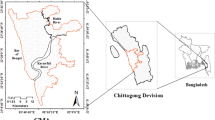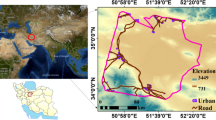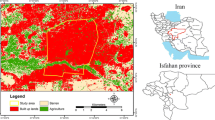Abstract
In present study, using artificial neural network (ANN), the land cover maps for three years (i.e. 2000, 2010 and 2019) were derived from Landsat optical data and the decadal spatio-temporal land cover dynamics was analysed. The classes delineated were built-up (urban and suburban), cultivated, vegetation, bare soil and river courses. Subsequently, the land cover change patterns were correlated with the LST values, which were retrieved from Landsat thermal data using mono-widow algorithm. The spatio-temporal clustering of high and low LST values (i.e. LST hot and cold spots) over different land covers, with special emphasis on built-up areas, was carried out. The variation in human thermal comfort levels during the period 2000–2019 was also investigated using thermal field variance index. The domain of the present study was Dehradun urban agglomeration.

Source: landsat 87, 23 Feb 2019)







Similar content being viewed by others
References
Ahmed, S. (2017). Assessment of urban heat islands and impact of climate change on socioeconomic over Suez Governorate using remote sensing and GIS techniques. The Egyptian Journal of Remote Sensing and Space Science, 21(1), 15–25.
Alfraihat, R., Mulugeta, G., & Gala, T. S. (2016). Ecological evaluation of urban heat island in Chicago City, USA. Journal of Atmospheric Pollution, 4(1), 23–29.
Anderson, J R., Hardy E. E., Roach, J. T., and Witmer, R. E., (1976). A land use and land cover classification system for use with remote sensor. USGS Professional Paper 964; Washington, DC.
Arora, M. K., Das Gupta, A. S., & Gupta, R. P. (2004). An artificial neural network approach for landslide hazard zonation in the Bhagirathi (Ganga) valley. Himalayas. International Journal of Remote Sensing, 25(3), 559–572.
Balew, A., & Korme, T. (2020). Monitoring land surface temperature in Bahir Dar city and its surrounding using Landsat images. The Egyptian Journal of Remote Sensing and Space Science, 3, 371–386.
Census of India (2011). Office of the registrar general and census commissioner, New Delhi, India. Available from: https://censusindia.gov.in.
Chen, X., & Zhang, Y. (2017). Impacts of urban surface characteristics on spatiotemporal pattern of land surface temperature in Kunming of China. Sustainable Cities and Society, 32, 87–99.
ESRI (2016). How hot spot analysis (Getis-Ord Gi) works. Accessed April 16, 2020 from http://proarcgis.com/en/pro-app/tool-reference/spatial-statistics/h-how-hot-spot-analysis-getis-ord-gispatial-stati.htm.
Gohain, K. J., Mohammad, P., & Goswami, A. (2020). Assessing the impact of land use land cover changes on land surface temperature over Pune city. India: Quaternary International.
Guha, S., Govil, H., Dey, A., & Gill, N. (2018). Analytical study of land surface temperature with NDVI and NDBI using Landsat 8 OLI and TIRS data in Florence and Naples city, Italy. European Journal of Remote Sensing, 51(1), 667–678.
Guha, S., Govil, H., & Diwan, P. (2019). Analytical study of seasonal variability in land surface temperature with normalized difference vegetation index, normalized difference water index, normalized difference built-up index, and normalized multiband drought index. Journal of Applied Remote Sensing, 13(2), 024518.
Guha, S., Govil, H., & Mukherjee, S. (2017). Dynamic analysis and ecological evaluation of urban heat islands in Raipur city India. Journal of Applied Remote Sensing, 11(3), 036020.
Guo, L., Liu, R., Men, C., Wang, Q., Miao, Y., & Zhang, Y. (2019). Quantifying and simulating landscape composition and pattern impacts on land surface temperature: A decadal study of the rapidly urbanizing city of Bei Jing, China. Science of The Total Environment, 654, 430–440.
Hang, H. T., & Rahman, A. (2018). Characterization of thermal environment over heterogeneous surface of National Capital Region (NCR), India using LANDSAT-8 sensor for regional planning studies. Urban climate, 24, 1–18.
Hasan, M. N., Hossain, M. S., Bari, M. A., and Islam, M. R. (2013). Agricultural land availability in Bangladesh. SRDI, Dhaka, Bangladesh, 42 pp. Landsat satellite imagery of path, 136, 5.
Hoffmann, E. M., Konerding, V., Nautiyal, S., & Buerkert, A. (2019). Is the push-pull paradigm useful to explain rural-urban migration? A case study in Uttarakhand. India: PloS one. https://doi.org/10.1371/journal.pone.0214511.
Hush, D. R., 1989. Classification with neural networks: A performance analysis. In: Proceedings of the IEEE International conference on systems engineering, 24–26 August 1989, Ohio, USA, 277–280.
Kakon, A. N., Nobuo, M., Kojima, S., & Yoko, T. (2010). Assessment of thermal comfort in respect to building height in a high-density city in the tropics. American Journal of Engineering and Applied Sciences, 3(3), 545–551.
Kanellopoulos, I., & Wilkinson, G. G. (1997). Strategies and best practice for neural network image classification. International Journal of Remote Sensing, 18(4), 711–725.
Kanungo, D. P., et al. (2006). A comparative study of conventional ANN black box, fuzzy and combined neural and fuzzy weighting procedures for landslide susceptibility zonation in Darjeeling Himalayas. Engineering Geology, 85, 347–366.
Kavzoglu, T., & Mather, P. M. (2003). The use of back propagation artificial neural networks in land cover classification. International Journal of Remote Sensing, 24(23), 4097–4938.
Li, J. (2006). Estimating Land Surface Temperature from Landsat-5 TM. Remote Sensing Technology and Application, 21(4), 322–326.
Maithani, S. (2014). Neural networks-based simulation of land cover scenarios in Doon valley. India. Geocarto International, 30(2), 163–185.
Maithani, S., Begum, A., Kumar, P., & Kumar, A. S. (2017). Simulation of peri-urban growth dynamics using weights of evidence approach. Geocarto International, 33(9), 957–976.
Matzarakis, A., Mayer, H., & Iziomon, M. G. (1999). Applications of a universal thermal index: Physiological equivalent temperature. International journal of biometeorology, 43(2), 76–84.
Mukherjee, S., Joshi, P. K., & Garg, R. D. (2017). Analysis of urban built-up areas and surface urban heat island using downscaled MODIS derived land surface temperature data. Geocarto International, 6049, 1–19. https://doi.org/10.1080/10106049.2016.1222634.
Paola, J. D. (1994). Neural network classification of multispectral imagery. MSc thesis, The University of Arizona, Tucson, USA.
Qin, Z., Karnieli, A., & Berliner, P. (2001). A mono-window algorithm for retrieving land surface temperature from Landsat TM data and its application to the Israel-Egypt border region. International journal of remote sensing, 22(18), 3719–3746.
Roy, S., Pandit, S., Eva, E. A., Bagmar, M. S. H., Papia, M., Banik, L., et al. (2020). Examining the nexus between land surface temperature and urban growth in Chattogram Metropolitan Area of Bangladesh using long term Landsat series data. Urban Climate, 32, 100593.
Rumelhart, D. E., Hinton, G. E., & Williams, . (1986). Learning representations by Back-propagating errors. Nature, 23, 533–536.
Sobrino, J. A., Jimenez-Munoz, J. C., & Paolini, L. (2004). Land surface temperature retrieval from LANDSAT TM 5. Remote Sensing of environment, 90(4), 434–440.
Tran, D. X., Pla, F., Latorre-Carmona, P., Myint, S. W., Caetano, M., & Kieu, H. V. (2017). Characterizing the relationship between land use land cover change and land surface temperature. ISPRS Journal of Photogrammetry and Remote Sensing, 124, 119–132.
United Nations, Department of economic and social affairs, population division (2019). World urbanization prospects: The 2018 revision (ST/ESA/SER.A/420). New York: United Nations.
Van de Griend, A. A., & Owe, M. (1993). On the relationship between thermal emissivity and the normalized difference vegetation index for natural surfaces. International Journal of remote sensing, 14(6), 1119–1131.
Voogt, J. A., & Oke, T. R. (2003). Thermal remote sensing of urban climates. Remote sensing of environment, 86(3), 370–384.
Wang, F. (1994). The use of artificial neural networks in geographical information system for agricultural land-suitability assessment. Environment and Planning A, 26, 265–284.
Willett, K. M., & Sherwood, S. (2012). Exceedance of heat index thresholds for 15 regions under a warming climate using the wet-bulb globe temperature. International Journal of Climatology, 32(2), 161–177.
Yang, J., & Qiu, J. (1996). The empirical expressions of the relation between precipitable water and ground water vapor pressure for some areas in China. Scientia Atmospherica Sinica, 20, 620–626.
Yu, X., Guo, X., & Wu, Z. (2014). Land surface temperature retrieval from Landsat 8 TIRS—Comparison between radiative transfer equation-based method, split window algorithm and single channel method. Remote sensing, 6(10), 9829–9852.
Zhang, Y. (2006). Land surface temperature retrieval from CBERS-02 IRMSS thermal infrared data and its applications in quantitative analysis of urban heat island effect. Journal of remote sensing, 10, 789797.
Zhang, Z., He, G., Wang, M., Long, T., Wang, G., Zhang, X., & Jiao, W. (2016). Towards an operational method for land surface temperature retrieval from Landsat 8 data. Remote sensing letters, 7(3), 279–288.
Acknowledgements
We gratefully acknowledge Department of Science and Technology, Government of India for providing support through the INSPIRE fellowship to Ms. Garima Nautiyal (first author), Doon University.
Author information
Authors and Affiliations
Corresponding author
Additional information
Publisher's Note
Springer Nature remains neutral with regard to jurisdictional claims in published maps and institutional affiliations.
About this article
Cite this article
Nautiyal, G., Maithani, S. & Sharma, A. Exploring the Relationship Between Spatio-temporal Land Cover Dynamics and Surface Temperature Over Dehradun Urban Agglomeration, India. J Indian Soc Remote Sens 49, 1307–1318 (2021). https://doi.org/10.1007/s12524-021-01323-8
Received:
Accepted:
Published:
Issue Date:
DOI: https://doi.org/10.1007/s12524-021-01323-8




